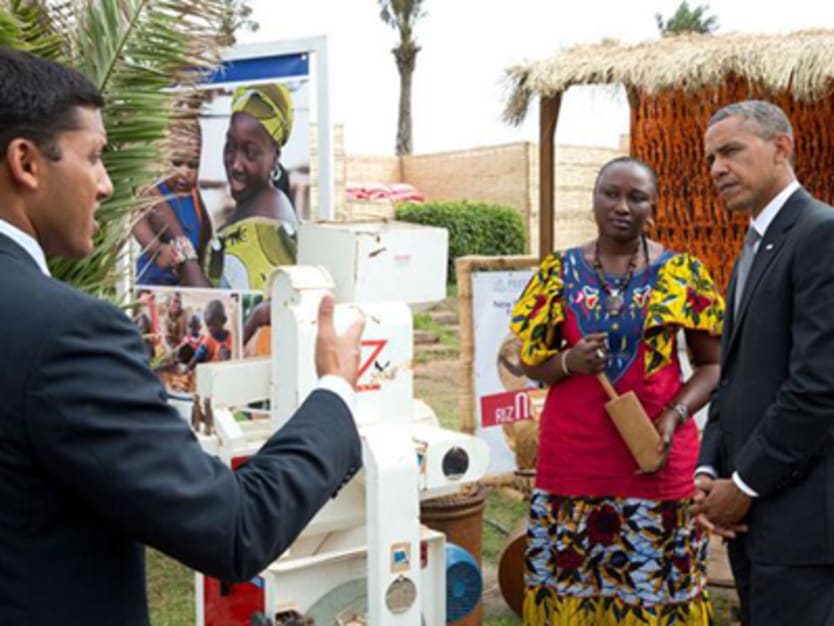
Read this week’s Development Buzz, “Rhetoric and reality: Obama’s vision for aid and trade with Africa.”
Feed the Future, U.S. President Barack Obama’s whole-of-government food security initiative, released its 2013 progress report last week in an ongoing effort to demonstrate the program’s commitment to evidence-based results and transparency.
The report gives the impression of a flurry of activity, yet it struggles to show what sort of monitoring and evaluation mechanisms are in place to demonstrate Feed the Future’s contribution to higher-level outcomes, like reducing poverty overall and “stunting” for children under the age of five, two of the program’s stated “aspirational goals.”
Since the initiative strives to coordinate action from a number of U.S. government agencies and a variety of other partners through a wealth of programs that approach the issue of food security from a number of different angles, coordinated transparency is no small task.
In many ways, Feed the Future’s commitment to building a parallel monitoring and reporting structure into its whole-of-government approach represents the “fulfillment of a promise” of better coordination made under Obama’s Presidential Policy Directive, Jonathan White, transatlantic fellow at the German Marshall Fund, told Devex.
There are a number of positive and impressive signals, like for instance report’s commitment to disaggregating data by gender.
As for tangible progress within the food security initiative, however, the report’s focus on outputs — which record activities performed — over outcomes — which measure the impact of those activities — limits the value of a monitoring system, even one as impressive in aggregating data across programs, actors and projects as Feed the Future’s.
Fulfilling commitments
Obama’s Presidential Policy Directive established the U.S. government’s Global Development Policy, which emphasizes coordination across government agencies to ensure that activities complement each other and are grounded in evidence.
“Coordinating resources across the U.S. government and requiring this reporting through Feed the Future’s monitoring system is one tangible example of fulfilling that commitment,” said White.
But the report is also a lesson in how difficult it can be to demonstrate coordinated impact that goes beyond simply reporting the completion of widespread activities.
Certainly, there is value in knowing that 7 million farmers were reached with new technology and management techniques. “But what did that result in? What did that do?” asked White.
The report tracks “improved use of maternal and child health and nutrition services” by documenting the “number of children reached” and the “number of people trained.” In this case, the expert is not sure whether the document is referring to higher caloric intake or diversified diets.
“You don’t see that level of granularity. You may have wider service provision, but is that service really higher quality. I know it’s not easy, but I think it’s really healthy to ask those kinds of questions,” commented White.
Room for improvement
All these shortcomings may just be the natural limitations of a young program, and future progress reports will better capture Feed the Future’s larger impacts once the initiative has had time to achieve and document them.
The latest report, for instance, announces that poverty decreased in Feed the Future countries by an average of 5.6 percent from 2005 to 2011; yet Feed the Future did not begin until 2010. The report does not mention, however, whether a shift towards more outcome-oriented reporting will occur once the program has been operating long enough to track its broader poverty and nutrition contributions.
For now, the report gives the impression of a monitoring and evaluation structure that captures action without detailing the critical reflection and learning feedback to guide and improve it in future program cycles.
This could be due to the fact that Feed the Future’s ”Learning Agenda,” by which the initiative wants to track the causal relationship between activities and impacts, has yet to be fully implemented.
“To meet this commitment, Feed the Future is currently planning, designing or implementing nearly 40 impact evaluations that will help us test new innovations, learn lessons, adapt development practices, and improve effectiveness,” the report says.
Similarly, the initiative is planning to implement a new cost-benefit analysis tool “that provides a basis for comparing the economic benefits of a project against its costs and helps guide sound investments.”
These are positive indications, and yet how they will be incorporated into the system of reporting that documents progress towards overall goals and communicates that progress to the public remains to be seen.
Looking forward to next report
Despite its limitations, Feed the Future’s data is “impressive compared to most initiatives,” says White. “It does get us farther to a whole-of-government approach.”
The scale of the outputs alone is impressive — 270,000 stakeholders implementing practices to mitigate risks and improve resilience to climate change.
Knowing what that produces, though, is the second-order challenge that Feed the Future’s ambitious commitment to transparency must confront as the initiative matures.
“In two years are we looking at the same 270,000 farmers and saying, ‘Ok, those 270,000 compared to similar smallholder farmer units across the country who didn’t have access to that, there are differences in the outcomes?”
We hope future reports will answer those questions.
Read more on U.S. aid reform online, and subscribe to The Development Newswire to receive top international development headlines from the world’s leading donors, news sources and opinion leaders — emailed to you FREE every business day.


